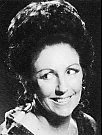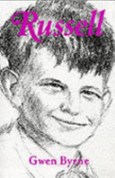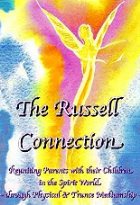The Russell Connection : Reuniting
Parents with their Children in the Spirit World through
Physical & Trance Mediumship
by Gwen Byrne, Edited by Karl Jackson-Barnes Psychic Book
Club Publishing (November 10, 2014)
A review By Dr. M. Cristina Zaccarini
 Gwen
Byrne experienced every parent’s worst nightmare,
when her nine-year-old son Russell (pictured left) passed
away in 1963. Her loss led her to visit mediums and learn
about the afterlife in an effort to maintain a connection
to him. Byrne’s first book, published in 1994, was
the product of copious notes from readings with mediums
and a multitude of experiences related to this quest to
maintain contact. Gwen
Byrne experienced every parent’s worst nightmare,
when her nine-year-old son Russell (pictured left) passed
away in 1963. Her loss led her to visit mediums and learn
about the afterlife in an effort to maintain a connection
to him. Byrne’s first book, published in 1994, was
the product of copious notes from readings with mediums
and a multitude of experiences related to this quest to
maintain contact.
Western interest in the spirit world was slowly on the rise
at the time of her book’s publication; however, as
Byrne would note, a person’s visit to a medium tended
to be kept secret, rather than shared, especially in the
U.K., where discussions of the afterlife were highly regulated.
Indeed, there were restrictive clauses prohibiting any discussion
of the afterlife in U.K. radio broadcasting codes, until
Michael Roll challenged the Radio Authority to the European
Court of Human Rights and achieved the removal of these
clauses in 1994. Even today, there is still a marked difference
between the U.K. and the U.S., when it comes to discussions
of the afterlife on television. Thus, the publication of
Byrne’s first book in 1994 coincided with a shift
in the ways that people thought of, and spoke about the
afterlife in the West.
In the 1990s, the U.S. saw the growing popularity of mediums
such as James Van Praagh, who appeared on the television
show “The Other Side,” and, by 1999, John Edward’s
“Crossing Over,” as these fuelled interest in
afterlife communication. Gradually, these led to the present
day popularity of such productions as “Long Island
Medium,” and “The Haunting Of...”
While U.S. shows focused primarily on the expertise of the
medium, as they communicated with the world unseen, to bring
comfort to the bereaved, Byrne’s homeland of the U.K.,
provided a different environment.
Afterlife investigator Michael Roll explains
that serious discussion of the afterlife remains prohibited
on television there, even today; however, information about
afterlife communication in books, and in practice often
went beyond the mere focus on the work of the medium, as
it had in the U.S., emphasizing instead, the grieving person’s
ability to communicate. (http://www.cfpf.org.uk/)
In the U.K., the publication of Spiritualist
investigator Robin Foy’s book, In
Pursuit of Physical Mediumship, in 1996, was a
‘how to’ instructional book for those seeking
to form a home circle through which a group of sitters could
study the means by which to manifest their loved ones in
the spirit world. Foy’s book described the work of
amateur investigators in Scole, England, who had reported
phenomena that validated, through encounters with the spirit
world, the psychical research of noted 19th century researchers,
including authors, chemists and physicists such as Sir Oliver
Lodge, Sir William Crookes, Sir Arthur Conan Doyle - individuals
whose work could not be discussed on television in the U.K
up until today, without tremendous consternation.
These works were unfamiliar to Byrne as she came of age
in W.W.II. Consequently, despite having witnessed untimely,
mysterious and disturbing deaths around her as a child,
she remained uninterested in and unfamiliar with the concept
of afterlife communication until her son’s untimely
and tragic passing. Indeed, Byrne indicates that she had
had no psychic visions and had experienced no visitations
from the spirit world prior to her son Russell’s transition
to the spirit world, but that her experience with mediums
dramatically changed all that.
Despite Byrne’s unequivocal understanding that life
did not end with physical death, and that her son was indeed
still alive, but in another plane of existence, it was not
until August 1982, almost twenty years after his passing,
that the author was able to communicate directly with Russell.
Byrne’s book provides superb detail regarding how
this was achieved through direct voice mediumship, as well
as riveting accounts of over one hundred encounters with
Russell via seances.
 The story of this communication began while Gwen, a semi-professional
singer, (pictured left) was away from home during a performance.
Her husband Alf picked up the phone and was told that a
medium in the Midlands, U.K. had communicated with her son
Russell, who had supplied his parents’ phone number
by utilizing the painstakingly slow rapping technique made
famous by the first Spiritualists, the Fox sisters, in 1848,
in upstate New York.
The story of this communication began while Gwen, a semi-professional
singer, (pictured left) was away from home during a performance.
Her husband Alf picked up the phone and was told that a
medium in the Midlands, U.K. had communicated with her son
Russell, who had supplied his parents’ phone number
by utilizing the painstakingly slow rapping technique made
famous by the first Spiritualists, the Fox sisters, in 1848,
in upstate New York.
One week later, the couple visited the group that Russell
had contacted and Byrne indicates that Russell spoke, with
the words “hello Mum, hello Dad,” and sang a
song to his mother.
Gwen continued to attend séances until 1989; however,
Byrne’s later experiences and work would become relevant
beyond that date, not only for its comfort to herself and
family, but to a greater network of grieving parents, and
to any bereaved individual reading this book.
Grief therapy, especially when involving an untimely passing,
is an extremely challenging endeavor for the counselor.
The departed person cannot be brought back, and an inconsolable,
bereaved person can unfortunately sink into complicated
grief, depression and substance abuse. Grief therapists
are often left with few tools to help those who are bereaved,
and whose only comfort can be that of knowing that their
loved one is well.
Early scientists and authors, and later investigators such
as Michael Roll, understood the value of spreading the word
that life beyond physical death continues. Roll described
the materialization of his own father, who had previously
passed into the spirit world, and fought to spread the word
that this knowledge had ability to sooth, to some degree,
the pain of grief, in a way that grief therapy could not.
 Byrne’s 1994 account, detailing her personal experiences
witnessing the materialization of her son, and the power
it had for her own family’s personal healing was significant;
however, the value of this 2014 volume also lies in its
warmth and generosity of spirit, not only through thoughtful
and straightforward writing, but through its example of
comradery amongst other mothers who suffered through the
overwhelming pain of the loss of a child.
Byrne’s 1994 account, detailing her personal experiences
witnessing the materialization of her son, and the power
it had for her own family’s personal healing was significant;
however, the value of this 2014 volume also lies in its
warmth and generosity of spirit, not only through thoughtful
and straightforward writing, but through its example of
comradery amongst other mothers who suffered through the
overwhelming pain of the loss of a child.
Indeed, Editor, Karl Jackson-Barnes notes that he had “imagined”
Byrne’s story “would be one of tragic loss and
like many others…followed by a comforting collection
of spirit messages from mediums.” However, Jackson-Barnes
admits that he “couldn’t have been more mistaken.”
(16) The communication that Byrne achieved with mediums
may have been extraordinary, but it also led her, at the
insistence of her son Russell, in spirit, to bring together
a group of grieving mothers who would gather to communicate
with their children in the spirit world.
 In this most
recent 2014 publication, Byrne recounts the ways that
five, out of the fifty mothers in the group she created,
'Russell's Pink Panther Society', experienced contact with
their children in spirit. At a time when “no one dared
even mention“ visiting a medium, these mothers did
so; however, they also communicated individually with one
another’s children, engaged in automatic writing,
used home-made Ouija boards and formed “their own
self-help groups.”(23) Through this RPPS group, comforting
information about the worlds inhabited by their children
in spirit was shared among the grieving mothers, providing
important messages that will likely help many readers in
need of healing from grief.
In this most
recent 2014 publication, Byrne recounts the ways that
five, out of the fifty mothers in the group she created,
'Russell's Pink Panther Society', experienced contact with
their children in spirit. At a time when “no one dared
even mention“ visiting a medium, these mothers did
so; however, they also communicated individually with one
another’s children, engaged in automatic writing,
used home-made Ouija boards and formed “their own
self-help groups.”(23) Through this RPPS group, comforting
information about the worlds inhabited by their children
in spirit was shared among the grieving mothers, providing
important messages that will likely help many readers in
need of healing from grief.
The bereaved may fear that their departed loved one was
cheated from their time on earth and relegated to an eternity
“resting in peace,” and inactivity, or possibly
nothingness. Byrne states that Russell explains how the
young grow old on the other side and recounts how she and
her husband “were privileged to speak with Russell
as a man” during their “last time at a physical
phenomena séance.” (23) In what Russell and
others, like 18th century Swedish scientist and theologian
Emanuel Swedenborg has described as worlds of thought, where
“like attracts like,” Byrne notes that Russell
was happy working in the “Children’s Realms,”
and, motivated by the sadness of children who missed their
mothers, began his labor of love, the project of uniting
the spirits of children who had crossed over, with their
grieving parents. Hence, since Russell missed his mother,
he was drawn to children in a similar predicament.
Since Gwen was a singer, Russell often conveyed information,
including the process of his life work on the other side
through lyrics such as these:
“They’re sad because they miss
their Mums and Dads, then I came up with this idea. I’ll
form a contact club, to prove that we are here.’
‘…I’ve already contacted my dear Mum.
‘How do you do that ?'...It’s easy…just
form a thought and put it in their head.’
‘I’ll show you how’ and so I did…”
Those who are grieving may long to hear that their departed
loved ones retain identifiable personality traits, while
continuing to grow in their new lives in spirit. It was
precisely because of his ability to sing and make people
laugh that Russell engaged in the work that he was doing
in the world of spirit, according to Byrne. Russell noted,
in the lyrics to this same song, that he was told “Russell,
we have a job for you, we need a little clown….someone
to make others laugh’”… “to lift
them when they feel down.’ (19)
Interestingly, Byrne details not only how
the personality is maintained in the spirit world, but the
ways in which the spirit grows in maturity as well. Complementing
19th century U.S. Spiritualist understandings of continued
growth and learning in the spirit world, Byrne explains
that Russell, who had passed to spirit so young, had grown
to adulthood, and chosen to “adopt a child”
in the spirit world, thus experiencing parenthood and helping
the spirit of a younger soul in need of parenting. (62)
The bereaved person may experience a survivor’s guilt
and unhappiness that their loved one cannot go on to enjoy
intimate relationships and earthly enjoyments. Byrne explains,
in Russell’s words, that in his world “when
we find people we like, we can be together all the time
if we want. We don’t have to sign a piece of paper
- but we can still find someone and love them.”
I have heard many mediums suggest that a person in the afterlife
will be drawn to the spouse for whom they felt more affinity,
and that a person may even choose to be with two spouses.
Byrne’s explanation is in keeping with this, as she
notes that Russell explains that it all depends on “who
you love the most.”
As has been described by many, including Emanuel Swedenborg
and Helen Greaves, in Testimony of Light (2005), as well
as authors and out of body travelers including William Buhlman
and Jurgen Ziewe, one can initially inhabit a realm in the
afterlife where eating and drinking are possible and earthly
desires can be fulfilled, dependent upon what a person wishes.
Byrne explains that Russell “did at first,”
have his desire for food met, when he arrived, but that
later he did not need this. (155)
Just as Robin Foy had described in his work, the mothers
received ‘apports,’ objects taken from somewhere
in the material world (and deemed unnecessary to the original
owner) and transported to the séance room. Indeed,
it was Byrne’s apport, a gift  from
Russell during Christmas of 1982, of a toy Pink Panther,
that came with the request that Gwen help with the mission
of reuniting children in spirit with their parents. This
led Byrne to create 'Russell’s Pink Panther Society'
(RPPS). “Now I’ve always liked the Pink Panther,
so I’ll send one to my Mum! Oh that will make her
laugh I know, and stop her feeling glum,” explained
Russell.(19) from
Russell during Christmas of 1982, of a toy Pink Panther,
that came with the request that Gwen help with the mission
of reuniting children in spirit with their parents. This
led Byrne to create 'Russell’s Pink Panther Society'
(RPPS). “Now I’ve always liked the Pink Panther,
so I’ll send one to my Mum! Oh that will make her
laugh I know, and stop her feeling glum,” explained
Russell.(19)
Reflected in this portion of the story, is the conveyed
message that Gwen can help herself by helping other mothers.
Readers who are interested in signs from the spirit world
will be fascinated to learn the mechanics of this process,
and how sharing knowledge of the apports helped to bond
the mothers in the RPPS. Indeed, it is this bonding among
women that makes the story so compelling.
Just as in the 19th century, the Spiritualist publication
“Banner Of Light,” often encouraged readers
to try communication on their own, because they too could
be mediums, the book explains the way that mediumship skills
can be developed.
Byrne believes that all can be mediums, but the difference
is that some individuals are cognizant of these abilities,
while others have switched off their connection to the spirit
world. For example, Russell tells his mother that “B,”
who communicates successfully, does so because she “perfected
the art of listening” during childhood, and understood
the “value of silence.”(60-61). Yet, Russell
warns Gwen that it is “easier” to have an “intermediary”
because “it would take very little…for you to
just give up on life,” and the purpose of life is
to do the “great deal of work” that is ahead.”(61)
Consequently, the mothers often communicate with their own
children in spirit with the assistance of other mothers,
doing so on one another’s behalf. For example, one
evening, a mother in the RPPS, Margaret Prentice, had the
thought to ask Russell to let her know that her son Richard
was with him. Soon after, another mother called to give
a validation that Russell was there with her by correctly
describing an article of distinctive article of clothing
that Margaret was wearing precisely at that time.(240)
These anecdotes, revealing the bonds among mothers in the
RPPS who provided one another with support at this most
difficult time, will doubtlessly inspire.
This engaging book provides readers with vivid and interesting
depictions of the afterlife, and exciting séances
with such mediums as Rita Goold, where the spirit of the
famous medium Helen Duncan is said by Byrne to have appeared.
Those who wish to research the material further can consult
with Michael
Roll’s website, which describes related experiments.
Sociologists and students of bereavement therapy will find
that the book provides a glimpse into the warm and loving
comradery that developed among grieving mothers in this
unique self-help group.
That Byrne has described seeing her son
materialize, is uniquely comforting, as are the other examples
given by Byrne of materializations; however, the self-help
component, which has not been captured often enough in written
narratives or media sources in the U.S., interwoven in this
lovely book provides readers with a unique, uplifting and
beautiful story that is sure to help bring comfort and help
heal many broken hearts.

BUY E-BOOK VERSION FROM AMAZON
 Dr.
M. Cristina Zaccarini Dr.
M. Cristina Zaccarini
Associate
Professor, Co-Director of Asian Studies
Adelphi University
300 South Avenue
Garden City, NY 11530
email: zaccarin@adelphi.edu
|
|